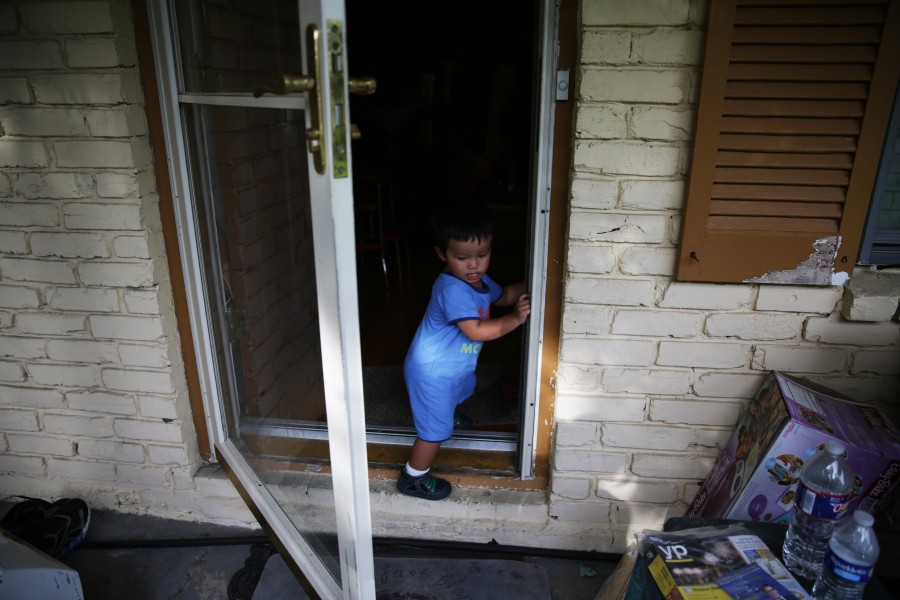“No union is more profound than marriage, for it embodies the highest ideals of love, fidelity, devotion, sacrifice, and family. In forming a marital union, two people become something greater than once they were.”
This is how Justice Anthony Kennedy began the final syllabus paragraph of the decision that would forever change the course of history LGBT in America. On June 26, 2015, marriage equality became an unequivocal and constitutional right in all 50 states, Puerto Rico and US territories with a 5-4 ruling from the Supreme Court. The United States therefore became the twenty-second country in legalizing marriage between same-sex couples.
There are some rights that are taken for granted and those that derive from marriage are among them. However, for same-sex couples those rights may mean the difference between dignity and humiliation, and between life and death.
Before the decision came down, La Huella Digital spoke with several couples and families who fought in a court of law to have the same rights as any married person in America. They told us their stories, the challenges they faced, the fears they felt and about the bright future that awaits them now.
Paul / Randy
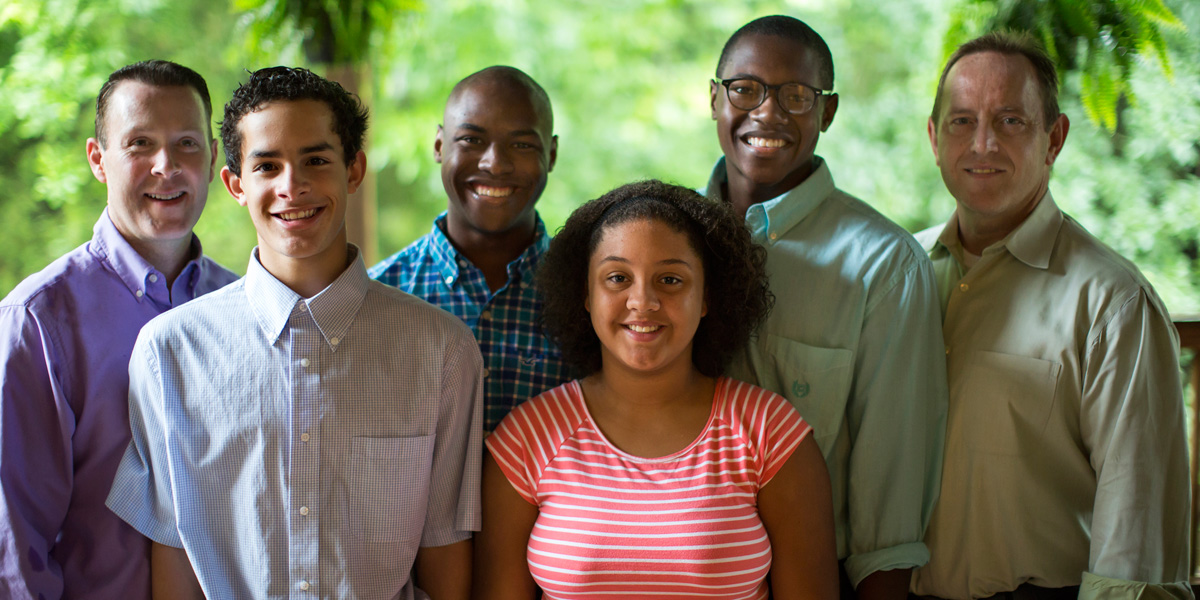
Photo: Tyler Essary/Kertis Creative
Paul Campion (far left) and Randy Johnson (far right) with their four children. With same-sex marriage now legal in all 50 states, both spouses may be considered parents to all four children.
Elizabeth Cotte
When Paul Campion was diagnosed with cancer in 2012, his husband Randy Johnson got scared. He feared Paul’s disease, but he was also apprehensive by the helplessness the family would face if something happened to his partner of 27 years. Paul and Randy live in Kentucky, a state that, at the time of diagnosis, did not recognize either their marriage or their parental rights over their four children. One of the men was the legal father, the other was a just a “guardian.” DeSean, one of Paul and Randy’s sons, hoped that the Supreme Court’s decision to extend the right to marry to same-sex couples across the country would give his parents a break economically and emotionally, and strengthen the family. “I want to see us as equals and that we have the same rights as others,” DeSean said.
The situation was similar for nurses April de Boer and Jayne Rowe. They challenged Michigan’s law that legally prevented them from sharing parental rights and responsibilities. One of them had an adopted child and the other had adopted two girls, but the two women felt they were mothers to all three. The state, however, would not recognize them as such, and the couple filed the lawsuit. The case would eventually be combined (as was that of Campion and Johnson, as well as others) with Obergefell vs Hodges, a case that was reviewed favorably by the Supreme Court. Equality became the law of the land on June 26, 2015: same-sex marriages were legalized in all 50 states, Puerto Rico and U.S. territories.
These are two of the approximately 300,000 same-sex couples raising children in America. Some are married, others in civil unions, many in a domestic partnership, but most a significant number of those couples have children. Tens of thousands of minors have been given a “different” treatment since families with gay and lesbian parents began to be part of the social fabric of this country.
The regard of families has been different and restrictive due to a myriad of factors, ranging from inequality before the law (prior to the opinion of the court in the case of Obergefell vs Hodges), to ignorance and prejudice, and including the regulations recently imposed to try to prevent gay couples from having a family through adoption.
Because of these laws and statutes, children of gay couples do not enjoy the same benefits and recognition as children born or adopted by opposite-sex couples. A typical example is that of a same-sex couple where one person is the biological parent, but neither the marriage relationship nor the child relationship is recognized. In that case, if one parent dies, the child cannot inherit any benefits. If the biological parent dies, then the child is denied the right to continue living under the tutelage of the surviving parent.
In the majority opinion and syllabus of the Court who voted in favor of extending the legality of marriage throughout the country, Justice Anthony Kennedy wrote: “… many same-sex couples provide loving and nurturing homes to their children, whether biological or adopted…Without the recognition, stability, and predictability marriage offers, children suffer the stigma of knowing their families are somehow lesser. They also suffer the significant material costs of being raised by unmarried parents, relegated to a more difficult and uncertain family life. The marriage laws at issue thus harm and humiliate the children of same-sex couples.”
Justice Kennedy’s words bring comfort to parents like Randy Johnson, who says that trying to legalize his family required an invested an energy that could have been used to strengthen it. But the Court’s decision has not completely cleared the way for same-sex couples.
Days before the long-awaited decision from the Court, Florida attorney Myrna Maysonet claimed that, “the opinion of the Court [at that time, she expected the Court would rule in favor of marriage equality, and it did] does not automatically resolve the defenselessness of the tens of thousands of children of same-sex marriages, because when relationships have not been clear in affiliation or irregularities arise, they have been resolved on a case by case in family court.”
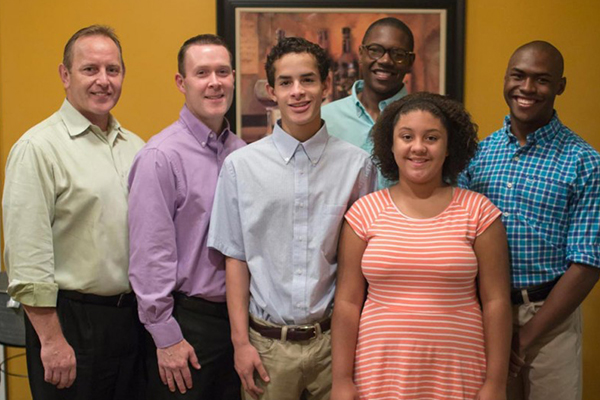
The entire family took part in the lawsuit that went before the Supreme Court. (Photo:Tyler Essary/Kertis Creative)
Same-sex couples with children will still have to go through legal paperwork, just as before they did before the June 26 decision that placed them in a position with equal rights and responsibilities. The difference is that now the courts in the country will be forced to consider new and diverse family structures: a lesbian couple having a biological child; the same-sex marriage with a biological child of one spouse and an adopted son on the other; the children that came through a surrogate womb; the child born of one woman’s ova and carried to term by her spouse, and who are both therefore, biological mothers.
Most of the organizations working for LGBT rights suggest that parents seek legal advice because, although it carries an expense (second-parent adoption can cost between 3,000 and 5,000 dollars, including a socio-economic study, attorney fees, and court costs), it is important not to jeopardize the process. In fact, after the historic decision on June 26, law firms began receiving calls from people who, “without full rights”, consider that it will now be easier to become parents through a second adoption, or from those who want to request an affidavit of parentage.
There are in fact, many issues that remain outstanding. According to Maysonet, “although the situation of many same-sex families will be legalized, the scenarios are many (see box). Judges will make determinations on a case by case basis, taking into account situations such as how the child was born, and if there is another parent who can claim rights, as in the case of a woman who previously had a child with a man and then he wanted to retain his parental rights.”
For activists working for the rights of LGBT families, the Supreme Court’s ruling is a starting point for new battles against laws that discriminate against same-sex marriage, such as the one currently in Michigan. The law states that an adoption agency may refuse a couple for reasons of conscience. And most of those, as Maysonet said, will be resolved on a case-by-case basis.
***
The following are some possible scenarios in future adoption cases:
Scenario 1
Children born after June 26: It is assumed that after the Supreme Court’s favorable decision, children born after June 26 will enjoy the benefit of being equal before the law with either two fathers or two mothers (if no other person is claiming parental rights). On the birth certificate, parents will appear as Parent 1 and Parent 2. However, organizations like Lambda Legal say that non-biological parents should complete the process of adoption or have an affidavit of parentage even when both names are on the certificate birth.
Scenario 2
The biological child of someone in a civil union or a domestic partnership, but who is not married, and in which no other person is claiming parent rights. The non-biological parent can apply to become a legal parent. In most states, it is a relatively simple process that requires filling out an application and a hearing before a family court judge.
Scenario 3
A child who was adopted by one of the spouses as a single parent. The other spouse can become a putative parent. The case of Gregory Bourke and Michael de Leon is an example of this scenario. The Kentucky couple was also included in the cases consolidated before the Supreme Court. Bourke is the adoptive father of their two children and De Leon became a legal guardian.
Scenario 4
Children adopted by unmarried same-sex couples when marriage was not legal in their state before the Supreme Court ruling. This was the case of the April de Boer and Jayne Rowse. De Boer has an adopted child and Rowse is the adoptive mother of two. Their case was part of the lawsuit consolidated before the Supreme Court. After the decision of the Court, they may marry and adopt the children in their state.
Scenario 5
The children of married gay or lesbian couples or cohabitating couples where there is a parent from a previous relationship who is retaining parental rights. The child will not have a third parent, but it may be ordered in court that the partner or spouse without rights become guardian or legal guardian. In places like California, there is a law that goes beyond that. SB 274 entitles children to receive financial and emotional support of all persons in their life with a parental role.
Valeria/Sophy
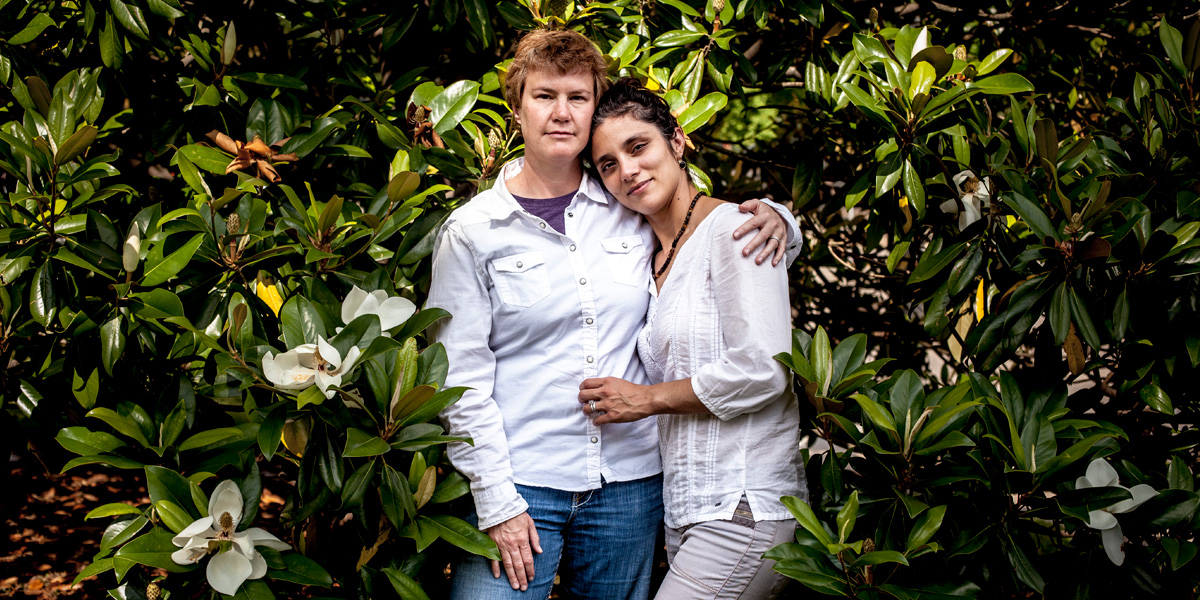
Photo: Andrea Morales
Before nationwide marriage equality, Sophy Jesty (left) and Valeria Tanco (right), both veterinarians, experienced firsthand the stinging loss of benefits as their family moved from New York to Tennessee.
Cary Tabares
In 2009, while at Cornell University, Valeria Tanco and Sophy Jesty literally ran into each other. Sophy was getting off an elevator while Valeria was getting on. “I bumped into her without realizing it,” recalls Valeria amid a joyous laugh. They began to date shortly thereafter. In October of the following year, Valeria invited Sophy to dine at a restaurant in a Canadian castle in picturesque Banff. Sophy recalls being nervous, “I swear the whole time I thought she was going to break up with me.” But something didn’t quite fit. This spectacular, breathtaking scene wasn’t the place to end anything. Sophy’s worries would prove unfounded, as that night, Valeria proposed—and Sophy said yes. It was perfect.
They were on top of the world when they married in New York in 2011. Here were two professional women, with careers in veterinary medicine and with a brilliant future ahead of them. They began to pursue job opportunities where they could be in proximity to each other. As it turned out, the University of Tennessee gave both of them job offers. They packed their things, moved to Knoxville, and in 2014 welcomed their first child, Emilia.
Everything would go well, except for one thing: even though they had married in New York, at that time, Tennessee did not recognize their marriage. “Because we both have our own careers and our own abilities to generate income, the legal applications of whether our marriage was recognized were less important until we had Emilia. And then, to me, they’ve become more important than the sentimental part of what marriage is,” Sophy told Univision Noticias, days before the Supreme Court would legalize same-sex marriage throughout the entire United States.
The repeal of Section 3 of DOMA (Defense of Marriage Act) in 2013, which defined marriage as a union between one man and one woman, made it clear that the federal government could not deny same-sex couples the benefits of marriage.
The Court did not, however, rule on section 2 of DOMA, which stated that one state’s recognition of marriage between same-sex couples did not have to be accepted in another. If a gay or lesbian couple married in a state where gay marriage was legal, they were conferred the benefits of that state. But if they moved to a state where same-sex marriage was not recognized, those benefits were lost as soon as the state line was crossed.
This led to what was dubbed at the time as a “patchwork of laws”: 37 states had legalized marriage before the Court rendered its June 26 judgment. In Tennessee, Kentucky, Michigan, and Ohio, the appellate courts upheld the ban on gay marriage. The four states were sued by couples seeking legal protection for their families.
Valeria and Sophy, who experienced firsthand the snub of inequality as they moved from one state to another, were among those the couples who filed suit. With the help of the National Center for Lesbian Rights (NCLR), the couple sued the state of Tennessee. Their case then became one of those consolidated before the Supreme Court.
A Thousand Reasons for Equality
Legal protection is essential for any couple, especially if are children involved. “Being a family that was not legally recognized, we felt very insecure when we had to Emilia,” Valeria said. “It started to affect us in ways we did not know. She was born by emergency C- section. We were fortunate that at the time she came into the world, a judge had ruled that our family would be recognized, if even for a short time. At that time, Sophy had all legal rights as a mother, just like me. The problem came when what the judge had decided was overturned. We were no longer legally recognized as a family,” she said.
There are over 1,000 protections and benefits that are conferred to married couples. Since they are commonplace for opposite sex couples, most of those rights go largely unnoticed. But for same-sex couples these same rights are critical, because the absence of them may put their families at risk.
“When you come from a large family like I do, you don’t realize all the things that legally recognized families don’t have to think about that we do. For instance, if something had gone wrong during the C-section, Sophy would have had no recognition as a mother. Then what would happen to Emilia?,” Valeria emphasized. “Anyone who has children knows that at that moment, the last thing you want to be thinking about is: what would happen to my child if I’m not here?”
Equality before the law is of paramount importance. Benefits such as social security, retirement, inheritance, taxes, adoption and veterans benefits, among others, coincide on the point of marriage. Within our society, it is a very important institution. Indeed, the overarching theme of oral arguments before the Court last April was the dignity of marriage.
“What we are talking about here is not only constitutional theory or abstract rights. We are talking about the lives of people who are our neighbors, our relatives, people we work with, people with whom we are with every day. They are real and existing families. The families that we represent in court in our Ohio case represent people who have been together for decades. For example, there’s James Obergefell, whose husband died and the state does not allow him even the minimal dignity of having his name on the death certificate as his spouse,” said Omar Gonzalez-Pagan, an attorney for Lambda Legal, one of the organizations working for LGBT rights.
Pam and Nicole Yorksmith were also represented by Lambda Legal. They married in California, and live in northern Kentucky with their two small children. Before the Court’s decision in late June, their life was very complicated because Kentucky did not recognize their marriage. What was so commonplace for a couple in California was feat for another who lived in a state without marriage equality, just because they happened to be a same-sex couple.
“Nicole is the only person that can enroll Grayden and Orion into daycare. She has to write a permission slip for me to be able to pick up our children,” said Pam, days before the Court’s decision. That began to change on June 26, 2015.
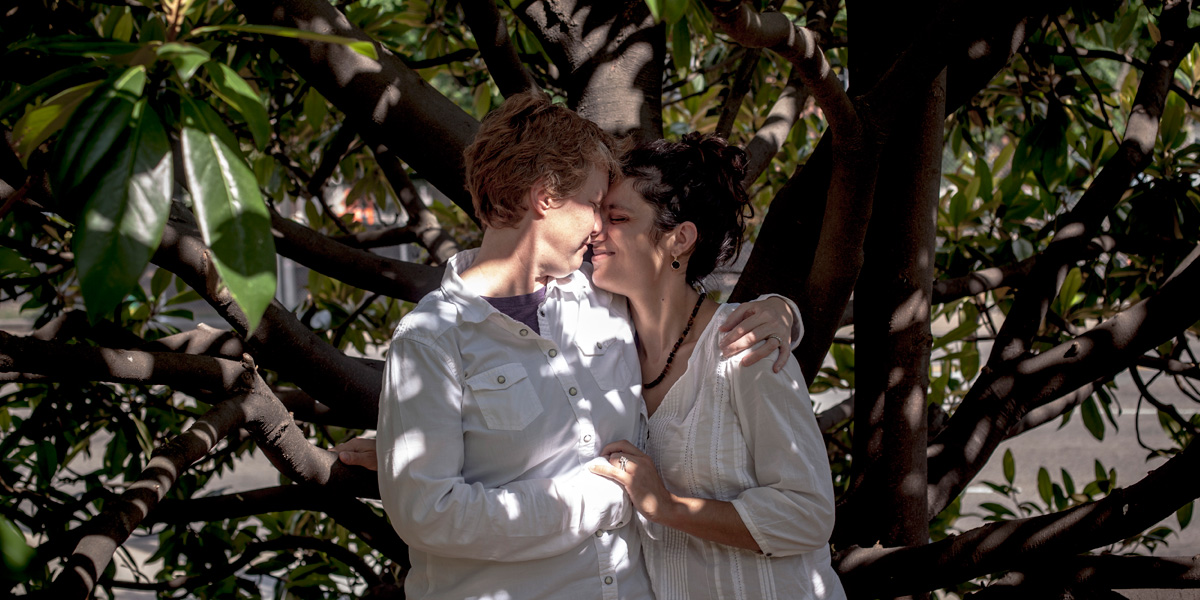
The apprehension was so palpable before the Court’s decision, that Sophy and Valeria came to believe they would have to reconsider their move to Tennessee.
Gaps to be Filled
Inequality before the law created undue financial burdens for same-sex couples. Although some had the financial resources to pay for the legal processes that would help ensure their rights to some extent, to demand that a couple pay extra because of their sexual orientation clearly amounted to discrimination.
“We get taxed on healthcare benefits that are provided by Nicole’s place of employment. So, we are a legally married couple from a state that legally recognizes marriage, but we live in a state that does not. If we were an opposite sex couple, it would not be imputed income for her—it would be a benefit that is not taxable. But because we live and work in a state that does not recognize our marriage performed in another state, it is considered imputed income for us,” said Pam Yorksmith via phone before SCOTUS’s decision. “We have had to spend a lot money and create a lot of paperwork to provide protections to me in case something were to happen to Nicole. Right now, in the state that we live in, her family—her parents, her brother, her cousins—have more rights to our two sons that I do.”
Valeria and Sophy were going through something quite similar in Tennessee. “Not recognizing our families legally puts the children at the greatest risk,” said Sophy. When they moved to Tennessee, the rights they had in New York vanished into thin air. “By not having our marriage recognized, from a purely legal point of view, our families are denied rights and obligations that other families like ours already have,” noted Valeria.
Before the court decision, inequality reared its head in many other ways, and is sure to be long before they are entirely eradicated. The armed forces are a special case when it comes to equality, or lack thereof. Its members serve the country selflessly and without distinction. But not all are treated equally. Those who chose military service do not enjoy the same rights when they happen to be LGBT.
Iris Delia Maritza Rivera Rivera and Lopez Aviles -part of the case presented in Puerto Rico by Lambda Legally, have been together for almost four decades and have a daughter who now attends college. Although Iris is a veteran of the war in the Persian Gulf, she was denied coverage benefits for her spouse and daughter. They wanted to get married in Puerto Rico, but didn’t have that option, and being married elsewhere did not matter—marriage equality had not come to the island.
This was one of the loopholes DOMA had left behind. Up until the June’s landmark decision, veteran’s benefits were given based on place of residence, not the place of celebration. That is, if a couple in which one spouse–a member of the armed forces—was married in New York and then, as a matter of duty, was transferred to Puerto Rico, that couple lost all their marriage rights. In essence, gay and lesbian members of the armed forces who were married in one of the 37 states that recognized equality instantly became second-class citizens when they moved across state lines into a place that didn’t recognize their marriage.
In the interview with Univision Noticias, Valeria gave us insight into one of her fears, “to know that legally Emilia would have no one but me–because my family lives in Argentina and I’m here by myself—worries me every day. Each passing day is a gift from God, and I think having both parents, just like every other family, would be a tremendous relief.” The apprehension was so palpable before the Court’s decision, that Sophy and Valeria came to believe that they would have to reconsider their move to Tennessee.
With the June 26 decision, Valeria and Sophy, Pam and Nicole, Iris and Maritza, will step out of their state of legal limbo and will no longer be vulnerable. Now their families are families in every sense of the word.
Christine / Jen

Photo: Almudena Toral/Univision Noticias
Christine (left) and Jen (far right) share a moment with three of their four children outside their home. Up until the week following the Supreme Court’s decision to legalize same-sex marriage, the couple found it difficult to obtain health care insurance for Jen.
Eulimar Núñez
Christine Raby and Jennifer Dupree would like to spend the rest of their lives together. They met in high school, took different paths and years later, with one child each, they met again. They decided to marry but they had to leave Texas to a state that recognized their union. They traveled 2,000 miles to Vermont to say, “I do.” And in return, they found that their marriage would be recognized when bills came due, but not for the enjoyment of rights.
Jen quit her job–and as a consequence, her health insurance–to take care of the couple’s two children, Selena and Tobias. Until the Supreme Court’s June 26 decision legalizing same-sex marriage nationwide, healthcare was a commodity denied to her. Despite being married legally in Vermont and considered married in 35 others, she failed to receive the medical benefits that Christine’s job offered. She couldn’t afford any other coverage either because she had married Christine.
“I was hoping that because my job —The University of Texas MD Anderson Cancer Center— gives benefits to opposite-sex married couples, they would also honor our marriage, since it was legal. I called Human Resources and I asked them if I could get benefits for my wife and they said no. That if it was a man I could cover him, but I couldn’t cover her,” recalls Christine in an interview with Univision Noticias.
They could not afford the cost of an individual insurance for Jen, even with Obamacare, which would have cost her $580 a month with very little benefits. “As far as the government was concerned, we were legally married. So it didn’t want my income, it wanted our tax return, which meant that even though I wasn’t working and made zero dollars every year, I had to claim her income.” The same happened when she applied for Medicaid.
Jen has lived without health coverage for the last two years. As a result, she has had no access to preventive medication to control her severe asthma. Her condition has considerably worsened. She also has hypothyroidism, a condition she needs to monitor regularly, and anaphylaxis, as well as other allergies. She should have regular checkups for cancer and cardiovascular disease, both of which are common in her family.
Not buying her insurance was a very tough decision, says Christine. “I was upset and I was very worried, because I know Jen has a lot of health problems now. We would pray that no major medical crisis would happen. I was scared.”
Discrimination: The Main Problem
The LGBT community faces reinforced disparities due to social and systematic segregation and inadequate access to healthcare. According to the Fenway Institute, gay, lesbian, bisexual, and transgender people are more likely to hide unmet health needs and have more difficulty getting insurance, which translates to a higher incidence of disease, mental illness and drug use. It is common for them to experience discrimination when they go to the doctor.
More than half of those surveyed by Lambda Legal for the report When Health Care Isn’t Caring (2010), said that they were denied some type of needed care. For example, there medical providers who refused to touch them, used excessive precautions, abusive language or blamed them for their condition.
In many places across the country, going to a hospital remains an unpleasant and uncomfortable experience for LGBT people. Human Rights Campaign (HRC) investigated hundreds of hospitals across the U.S. and established a ranking of the ones that offer better services and have non-discrimination policies.
“Unfortunately, some people in some parts of the country don’t have any options. But cities are probably going to have a few options,” says Tari Hanneman, Deputy Director of the Health and Aging Program at the Human Rights Campaign Foundation, who oversees the annual LGBT Healthcare Equality Index. “In addition to doing a checklist, we really work with the hospitals and provide training,” she says. The objective is to create a more inclusive environment for LGBT patients.
The goal, says Hanneman, is to prevent LGBT community from continuing to experience abuse, as described by some in the report: “I couldn’t believe it – as I walked back to see my partner and our newborn, and employee stopped me and asked who I was. When I said ‘the other mom,’ she rolled her eyes and walked away saying, ‘I don’t believe this,” says a lesbian mother after the birth of her first child. “After I mentioned that my husband would be visiting me, the staff, who had been very friendly, turned very cool – and I saw a lot less of them, even when I really needed help,” recalls a gay man, hospitalized for a lung condition.
The Main Disparities
The only way that doctors, nurses and other healthcare providers can offer the support they need, according to GLMA (Health Professionals Advancing LGBT Equality, formerly Gay & Lesbian Medical Association), is for them to be aware of the more obvious problems the community faces.
Many gay men, for example, have a hard time coming out to their doctors, but they need to do it in order to undergo HIV testing and receive vaccines against hepatitis, as they face a higher risk of infection. Among lesbians there are more cases of breast and cervical cancer due to infrequency of tests; they also experience high rates of chronic stress from discrimination that results in depression and anxiety.
Hanneman highlights that providers sometimes conflate sexual orientation with sexual behavior. “That’s another area where providers really need to be aware and conscious of what they’re doing. If you have a patient you need to be asking them about their sexual behaviors and not making assumptions based on the fact that you said you were a lesbian. They need to really understand their patients and what their needs are. That’s another area where the training is really important.”
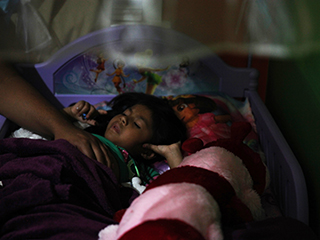
Michael Raby, Christine’s eldest son, tucks in Selena, his sister. “My family is unconventional but it is normal,” says Michael.
What Changes?
After the Supreme Court legalized same-sex marriage, Christine received an email from hospital’s president, Dr. Ron DePinho: “I’m pleased to announce that beginning Wednesday, July 1, 2015, benefits-eligible faculty, staff and retired employees may enroll their same-sex spouses, as well as dependent children of these spouses, in MD Anderson benefits upon presentation of a marriage certificate. These are the same services – at the same costs – available to opposite-sex spouses upon presentation of a marriage certificate.”
Equal marriage gives gay couples the opportunity to fully engage in the American system with full rights and privileges that their straight neighbors have had, says Christopher M. Cannon, senior manager of the National Coalition for LGBT Health / HealthHIV. “These rights and privileges makes the couple feel secure and allow their relationship to be fully recognized. We are going to need providers who are open, asking the right questions and not making assumptions that can negatively hurt the individual’s health outcomes. But for us, the bigger piece right now upfront is the large number of individuals that will have greater access to medical care.”
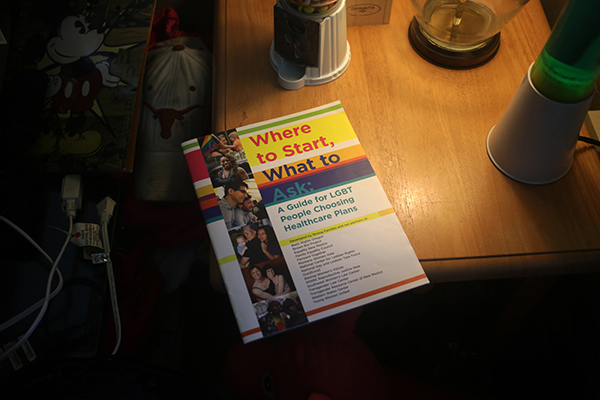
On Christine and Jen’s living room table rests a brochure with tips in choosing a health care plan. (Photo: Almudena Toral).
The decision was particularly significant in those states that did not recognize gay marriage, especially in Texas, which has the largest number of uninsured people in the country. “Many people in the state have refused to provide coverage because of their religious beliefs, among other reasons,” says Liz James, Executive Director of the Lesbian Health Initiative of Houston.
“What’s exciting is that policies grant rights and provide the legal framework to start changing things,” says James, who recalls that the situation has improved since 2010 with the approval of the Affordable Care Act, that prohibits discrimination based on sexual orientation or gender identity.
Hanneman thinks that the most important thing about the decision is that it will ease people’s fears. “It gives security to married couples. Many data show that the mental health of LGBT couples improves or becomes more stable when relationships are recognized by their governments,” she says. HRC will search for cases of discrimination in all areas: employment, housing and public accommodations. “It is still possible, in many states, to marry your partner today and be fired from work tomorrow.”
Hector Vargas, executive director of the GMLA, stresses that the current priority is to ensure that the providers and care systems are equipped -from a clinical and cultural point of view- to meet the medical needs of LGBT community. “What we’ve seen in the last 6 years (since the ACA started) is significant progress and we expect this to continue improving. Professional associations (American Medical Association, American Academy of Nursing, American Psychological Association and many others) continue to address in their own policies and statements, the health needs of the LGBT community. That will help us continue that momentum to make sure that health providers are more welcoming of LGBT patients and clinically confident to address the specific health needs that affect the community.”
Experts agree that providers need to be sensitive and welcoming. “LGBT people have had in general poor experiences in health care,” says Vargas. “That has created a lack of trust. Any visual cues in a provider’s office, magazines that are LGBT focused, signal to the patient that they can talk without fears.”
James adds that marriage equality is a personal matter for her. “I’m 60, I’m a lesbian and I came out I was 18. I never, never, never thought in my life that I would see the day when that happened. I didn’t think I was going to live long enough. I’m still sort of in shock. I went to the first Gay Pride Parades in Houston, I lost my best friend in 1984 (HIV), I’ve been through a lot. LGBT is should not be understood as a word. It is not one age, not one ethnicity, we are all different and the truth is we are not a community, we are in your community. We go to your church, to your parties, we work with you. We are your brother, your sister or your child. I think one of the things about this policy is that it will help us to be more visible. Policies are what tells people that they are okay. We are not done, but for people to be able to feel okay with who they are, to me that is such a triumph and victory.”
***
Human Rights Campaign prepared a document that explains what will change in terms of access to healthcare after same sex marriage was approved in the whole country.
Visitation rights
Hospitals are required by federal regulations to allow patients to choose who they want to visit them, regardless of their relationship. Additionally, hospitals are prohibited from barring visitors based on sexual orientation and gender identity. Unfortunately, although these rights have been in place since 2011, many people remain unaware of them, and some hospitals still adhere to outdated visitation guidelines that have narrow, noninclusive definitions of
family. Marriage equality will make it easier for married LGBT patients to assert their visitation rights in these non-compliant hospitals.
Medical decision-making rights
If you become mentally incapacitated and unable to communicate your medical wishes, a surrogate will make those decisions for you. Federal regulations require that hospitals defer to the surrogate a patient has designated – including same-sex partners – for medical decision making in the event of incapacitation. Unfortunately, if you do not have legal documents such as Advance Healthcare Directive that assigns your surrogate and outlines your medical wishes, hospitals will turn to what are known as state “default surrogate selection priority lists” and appoint a surrogate. A patient’s
spouse is always at the top of these default surrogate lists. Marriage equality will ensure that spouses in same-sex marriages will make medical decisions for their spouses, should they become incapacitated.
Health insurance options
Legally married same-sex spouses already have the right to enroll in any “family” or “spousal” plan offered through an Affordable Care Act (ACA) Marketplace, and health insurance companies are required to treat same-sex spouses the same as opposite-sex spouses. In addition, if you are legally married, you and your spouse may apply jointly for financial assistance through the ACA marketplace in your state. Same-sex couples who are newly married in their home state will qualify for a “special enrollment” period of 60 days in order to enroll a spouse through the ACA. If you receive health insurance through your employer and your employer extends health insurance benefits to spouses, same-sex spouses must have equal access to these benefits. Federal courts have consistently determined that denial of spousal benefits to same-sex couples, when the benefits are otherwise generally available, is sex discrimination and is illegal.
Marcia / Tanya
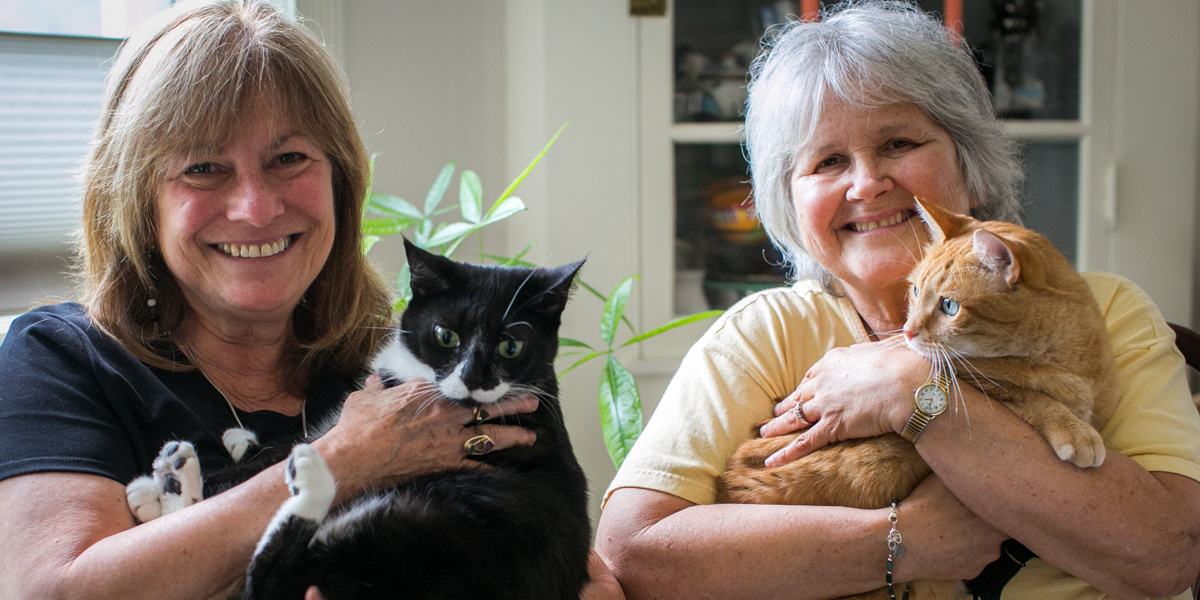
Photo: Kristyn Ulanday
Marcia Kadish and Tanya McCloskey were the first couple to marry in the United States when same-sex marriage was legalized in Massachusetts in 2004. After 11 years, the couple remains very much in love.
“It’s wonderful to be with each other anywhere we want to be publicly, and to be able to love each other wherever we are, to be able to hold hands,” affirmed Marcia Kadish. Kadish is one of the same-sex marriage pioneers in the United States. She and Tanya McCloskey were the first of the 600 couples who married on May 17, 2004, when same-sex marriage was made legal in Massachusetts, the first state in the United States to do so.
On that morning, Cambridge City Clerk Margaret Drury at 9:10 am pronounced the couple married. “You may seal this marriage with a kiss.”
What started at that moment was a story that the Supreme Court decision brought to a close on June 26: the legalization of same-sex marriage nationwide (see the timeline at the end of this chapter).
“Marriage has been wonderful,” Kadish added. “We’re accepted by everyone around us now.” For her and McCloskey, whom are still happily married, marriage is a public demonstration of much more than a legal commitment. They are wholeheartedly committed to each other. “We’re professing that, ‘I will take care of you. You will take care of me,’” says Kadish. “And we love each other.”
Despite their ecstatic experience, it took the Supreme Court eleven years to give same-sex couples the legal right to marry nationwide. And they did it in the midst of a persistent opposition. Before the court ruling, opponents of same-sex marriage in their diatribes seemed to be channeling Chicken Little. “The sky is falling! The sky is falling!” they’d cry. To them, giving gays and lesbians the fundamental right to marry, would bring about the end of civilization.
Facts are often difficult to accept, but they are true by definition. When the Netherlands approved the marriage between same-sex couples in 2000, the Dutch opponents wielded the same argument: that legalizing gay marriage would ruin society. But nothing happened. The thought that the legalization of marriage for gays and lesbian would be the downfall of society has proven to be unequivocally false, with no empirical evidence to speak of.
In an amicus brief to the Supreme Court filed by Human Rights Watch, the organization stated that “there have been no reports of the deterioration of the social order in the Netherlands, nor have the positive effects of marriage as an institution been undermined.” Divorce rates went down in the decade from 2001 to 2012, while a little more than three-fourths of children live in a household comprised of “two married parents.”
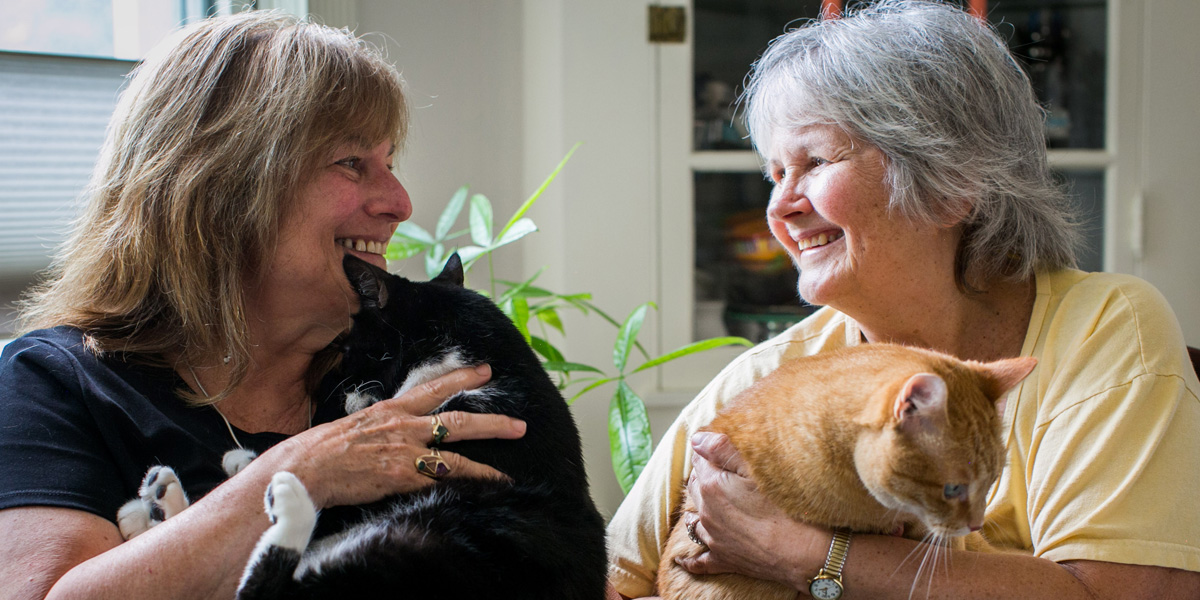
According to Marcia and Tanya, family experiences have strengthened their relationship. (Photo: Kristyn Ulanday)
According to HRW, similar happenings occurred in other countries that have approved same-sex marriage. In Canada, there were no “reports of public turmoil,” and as of 2008, marriage and divorce rates have stayed relatively constant; in Argentina, again, there were “no signs of social collapse,” and in New Zealand, “gay marriages aren’t affecting straight marriages as some predicted.”
In all cases it seems, the American Psychological Association’s 2009 premise is being fulfilled in the sense that, “There is no scientific basis to assert that lesbian and gay persons are not equally fit to marry or to become parents of healthy and well-adjusted children.”
In light of what has happened in cases like Marcia and Tanya’s, it did not seem necessary to review the experience of other countries. “Our relationship has gotten better and better and better over time. Every day, we love each other more. It is very special. It’s beautiful,” Marcia said. “Being together for so long has given us the opportunity to know each other and to go through different things in life: sickness, health, happiness, children, our families, the death of our parents. We’ve bonded through all these familial areas,” Tanya added.
That is not surprising. There are physical, psychological, and social benefits that married persons enjoy, but that up until June 26, 2015, were denied to same-sex couples.
These are things that, according to the couples interviewed, give meaning to the word “equality” and that are what it’s all about.
About This Project
The history of LGBT rights in the United States is long, complex, and far from complete. For over 40 years, the community has fought to gain equal standing in society through the establishment of laws. Along the way, seeds of acceptance have been planted in the hearts and minds of a nation, showing that love is love, and that people are well, people—with families, homes, jobs, and yes, dreams. Everyone experiences the same quotidian existence. A 2013 Pew study puts social acceptance for gays and lesbians at 55% and 58% respectively.
The genesis of the LGBT movement began in earnest with the Stonewall riots of 1969. The first application for a marriage license of a same-sex couple was in Minnesota in 1970. They were denied. In 1973, the American Psychological Association removed homosexuality from the Diagnostic and Statistical Manual of Mental Disorders. Since then, the LGBT community has inched forward in civil and human rights, but the road has been long and arduous. Marriage has been the most recent, granted as a constitutional right by the Supreme Court on June 26, 2015.
In this edition of La Huella Digital, the focus was on why the June 26 decision was so important. Beyond what has already been reported in the media, the idea is to highlight the stories of those who have been affected by the lack of rights that marriage equality brings. It was to give them a voice to tell their stories firsthand, and elucidate how devastating, dehumanizing, and demeaning it has been to be considered second class citizens. It was important to tell what still needs to happen to end stigmatization.
The original idea was to focus on Latino couples who have suffered such discrimination. Unfortunately, some were unavailable and others simply wouldn’t concede an interview for fear of further stigmatization. Homophobia and transphobia are not necessarily overt, but they are inscribed with letters of fire in the unwritten code of Latino culture. Overcoming that is part of the change that can be brought about by the Court’s decision.
But that is not all that needs to be overcome. There are still other situations that need to be addressed. According to GLAAD, here are a few:
1) A little over 33% of Americans “are still uncomfortable with LGBT people.”
2) In 29 states, a person who is gay, lesbian, or bisexual can still be fired because of their sexual orientation. For the transgender community, 32 states offer no protection on the basis of gender identity.
3) 40% of homeless youth are LGBT.
No matter your race, creed, religion, gender, sexual orientation, or gender identity, everyone is entitled to dignity. All Americans deserve the right to life, liberty, and the pursuit of happiness, as stipulated in the Constitution. Going forward, each time Univision Noticias produces a story on LGBT rights, it will do so with the hashtag #PasoALaIgualdad—a step towards equality. The Supreme Court’s decision was just that: a step. The journey has not ended.


